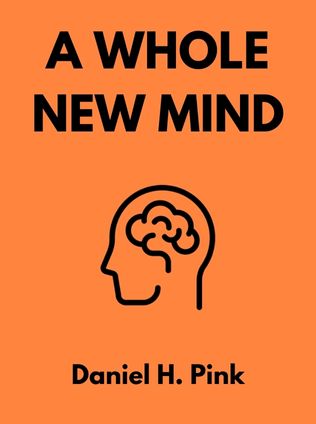
A Whole New Mind
Moving from the Information Age to the Conceptual Age
By Daniel H. Pink
Published 03/2005
About the Author
Daniel H. Pink is an influential author and speaker known for his innovative insights into the changing dynamics of work and human behavior. With a background in law and politics, Pink has served as a speechwriter for Vice President Al Gore and has contributed to numerous publications, including The New York Times, Harvard Business Review, and Fast Company. He is the author of several bestsellers, including Free Agent Nation and Drive, where he explores themes of motivation, autonomy, and the evolving nature of work. In A Whole New Mind, Pink delves into the emerging Conceptual Age, advocating for a shift from traditional left-brain skills to a new set of right-brain aptitudes that he argues are essential for success in the modern world.
Main Idea
The central premise of A Whole New Mind is that the era dominated by logical, linear, and analytical "left-brain" thinking—characteristic of the Information Age—is giving way to a new epoch where "right-brain" qualities like creativity, empathy, and holistic thinking are paramount. Pink suggests that traditional knowledge-based professions, such as law and engineering, are becoming less critical in the face of automation, outsourcing, and the proliferation of information. Instead, he argues for the importance of six key aptitudes—Design, Story, Symphony, Empathy, Play, and Meaning—which he believes are crucial for individuals and organizations to thrive in what he calls the Conceptual Age.
Table of Contents
- Introduction
- Right Brain Rising
- Abundance, Asia, and Automation
- High Concept, High Touch
- Introducing the Six Senses
- Design
- Story
- Symphony
- Empathy
- Play
- Meaning
- Afterword
Introduction
Pink opens the book by highlighting a "seismic shift" in the kinds of skills that are valued in society. He suggests that we are moving away from a world where jobs required primarily logical and analytical skills, toward one that prioritizes creativity, empathy, and holistic thinking. This shift, he argues, is driven by three main factors: abundance, Asia, and automation. These forces are making traditional left-brain skills less valuable while increasing the importance of right-brain abilities.
Right Brain Rising
In this section, Pink delves into the scientific basis for his argument, exploring the differences between the brain's two hemispheres. He references pioneering research by neuroscientist Robert W. Sperry, who demonstrated that the right hemisphere—often dismissed as inferior—actually plays a crucial role in tasks involving creativity, empathy, and holistic thinking. Pink uses the metaphor of a "neurological Mason-Dixon Line" to illustrate the division between the analytical, logical left brain and the creative, empathic right brain.
"The so-called subordinate or minor hemisphere, which we had formerly supposed to be illiterate and mentally retarded... was found to be in fact the superior cerebral member when it came to performing certain kinds of mental tasks." - Robert W. Sperry
Abundance, Asia, and Automation
The chapter discusses the three primary forces driving the shift toward the Conceptual Age:
- Abundance: The material prosperity of the modern world has led to an oversaturation of goods and services, increasing the value of beauty, emotion, and meaning. In an age where basic needs are easily met, people crave unique and aesthetically pleasing experiences.
- Asia: The outsourcing of routine white-collar work to countries like India and China has reduced the demand for certain traditional professions in advanced economies. This phenomenon emphasizes the need for skills that cannot be easily outsourced.
- Automation: As technology advances, machines are increasingly capable of performing tasks that once required human intelligence. This trend necessitates a focus on skills that are beyond the reach of machines, such as creativity and empathy.
High Concept, High Touch
Pink introduces the concepts of "High Concept" and "High Touch," which he argues are essential in the Conceptual Age. High Concept refers to the ability to detect patterns, create artistic and emotional beauty, and combine seemingly unrelated ideas into something new. High Touch involves the ability to empathize with others, understand the subtleties of human interaction, and find joy and purpose in life.
"High concept involves the capacity to detect patterns and opportunities, to create artistic and emotional beauty, to craft a satisfying narrative, and to combine seemingly unrelated ideas into something new." - Daniel H. Pink
Introducing the Six Senses
The "Six Senses" are the key abilities Pink believes will be vital in the Conceptual Age. These senses are not just complementary to left-brain skills but are essential for achieving both professional success and personal fulfillment. They are:
- Design
- Story
- Symphony
- Empathy
- Play
- Meaning
Design
In this chapter, Pink emphasizes the importance of design as a critical skill in the Conceptual Age. He argues that good design is not just about aesthetics but also about functionality and significance. Design combines utility with emotional impact, making it a powerful tool for creating meaningful experiences. Pink suggests that in a world of material abundance, good design becomes a key differentiator for products and services.
Sign up for FREE and get access to 1,400+ books summaries.
You May Also Like
The Subtle Art of Not Giving a F*ck
A Counterintuitive Approach to Living a Good Life
By Mark MansonRich Dad Poor Dad
What the Rich Teach Their Kids About Money - That the Poor and Middle Class Do Not!
By Robert T. KiyosakiHow To Win Friends and Influence People
The All-Time Classic Manual Of People Skills
By Dale CarnegieFreakonomics
A Rogue Economist Explores the Hidden Side of Everything
By Steven D. Levitt and Stephen J. Dubner



















